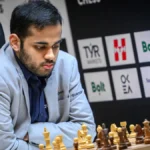Virgil Van Dijk’s Disallowed Goal Sparked Debate
The controversy around Virgil van Dijk’s disallowed goal against Manchester City has once again placed Premier League refereeing under intense scrutiny. With Howard Webb now almost three years into his role overseeing referees, he knows that supporting officials in such moments will never fully end the debate.
The decision, shaped by a complex part of the offside law, has created another moment in which fans, players, pundits and officials hold sharply different views. The response from Webb shows how subjective this area of the game remains.
Why Van Dijk’s Goal Was Disallowed
Virgil van Dijk thought he had scored an equaliser for Liverpool at the Etihad Stadium. However, referee Chris Kavanagh and assistant Stuart Burt ruled that Andrew Robertson had committed an offside offence. The VAR team supported the on-field call, stating that Robertson ducking under the ball placed him in an offside action.
This phase of play involves one of the most complicated aspects of the offside rule. When the ball travels towards goal and an attacking player in an offside position moves in a way that could influence an opponent, the situation becomes open to interpretation.
In moments like this, even when officials follow the law closely, the reaction is almost always split. The team affected believes the goal should stand, while pundits and fans often argue that the decision is too harsh or too technical. The debate rarely settles quickly.
Howard Webb’s Explanation
Howard Webb described the decision to disallow the goal as “not unreasonable.” His choice of words was important. He avoided calling it “correct,” because doing so would imply that the opposite view is wrong.
For Webb, the key point is that this incident lies in what he called the “subjective corridor,” where two different decisions could both be considered acceptable. In other words, there is no single correct interpretation. The law allows room for officials to decide based on what they see, and this naturally leads to debate.
By using the phrase “not unreasonable,” Webb made it clear that the officials had justification for their choice. At the same time, he acknowledged that others could interpret the moment differently without breaking the laws of the game.
Understanding the Offside Law Involved
Offside is covered by Law 11 of the IFAB Laws of the Game. The Premier League’s match centre also referred to this law when explaining the situation. The match centre stated that Robertson was in an offside position and made an “obvious action” directly in front of the goalkeeper.
An “obvious action” refers to something an offside player does that could impact an opponent’s ability to play the ball. In this case, Robertson ducking under the ball, very close to goalkeeper Gianluigi Donnarumma, was seen as such an action.
The law is designed to prevent offside players from interfering with defenders or goalkeepers, even if they do not touch the ball. The difficult part is that interference is not always easy to measure. It is often based on judgment rather than objective evidence.
What the Officials Said During VAR Review
The VAR audio revealed how the decision took shape. Assistant referee Stuart Burt played a key role, noting twice that Robertson was in the line of vision of Donnarumma. He also said Robertson ducked under the ball and was “very, very close” to the goalkeeper.
These observations helped shape the final ruling.
Inside the VAR room, assistant VAR Tim Wood guided the discussion. Wood stated that he agreed with the on-field decision and believed it was offside. He described the movement as “a clear, obvious action” that affected the goalkeeper.
VAR Michael Oliver was in the process of requesting a camera angle that would show the line of sight. However, after Wood’s input, Oliver confirmed the judgment. He said Robertson was in an offside position, close to the goalkeeper, and made an obvious movement. He finished with: “Check complete, offside.”
This sequence of communication shows how VAR officials work together. It also demonstrates that decisions are not always based on a single factor but on a combination of observations.
Did VAR Need to Check the Line of Vision?
One of the key questions raised by fans was whether the VAR team should have more thoroughly examined the goalkeeper’s line of sight. Howard Webb acknowledged this point. He explained that the decision did not rely solely on blocking vision.
He said the “obvious action” made by Robertson, along with his closeness to the goalkeeper, were enough on their own to justify the offside call. The law does not require every factor to be checked for a decision to be valid. Instead, any one of the interfering actions can be sufficient.
Webb’s response suggests that even if the line-of-vision angle had been reviewed, the decision might still have remained the same based on the other elements the officials observed.
Why These Decisions Always Create Debate
This situation highlights why offside controversies continue in modern football. The law contains elements that depend on interpretation, such as movement, influence and the actions of players without the ball.
When laws allow room for interpretation, disagreements naturally arise. What one person sees as interference, another may view as harmless movement. As Webb noted, the decision sits in a zone where both outcomes could be justified.
The reaction from supporters also follows a familiar pattern. The team who concedes the goal or has it disallowed feels hard done by, and former players often lean towards the perspective of attackers, believing goals should stand unless the interference is extremely clear.
Referees, however, must apply the law as written, even in its most complex moments.
The Challenge for Referees and VAR
Howard Webb’s response shows how difficult these moments are for officials. They must make quick decisions in high-pressure situations, interpret subjective actions and ensure they are consistent with the law. Webb knows that supporting his referees will not silence criticism, but he also understands the importance of backing the process.
VAR adds another layer. While it is designed to reduce clear errors, it does not eliminate all debate. When incidents fall into subjective areas, VAR will still rely on the judgment of officials rather than definitive evidence.
These moments demonstrate how football laws continue to evolve. Technology can help, but it cannot remove interpretation from the game.
The disallowed goal for Virgil van Dijk against Manchester City has reignited discussions around offside decisions in the Premier League. Howard Webb’s explanation shows that this incident falls into a grey area of the law where more than one interpretation can be considered correct.
The officials ruled that Andrew Robertson made an obvious action from an offside position and was close enough to affect the goalkeeper. While some fans and pundits disagree, the law supports the reasoning used by the referees and VAR.
As long as the offside law includes subjective elements, debates like this will continue. What matters is that officials apply the law consistently and transparently, even when decisions are difficult and unpopular.
FAQs
Q1. Why was Virgil van Dijk’s goal disallowed?
A. It was ruled offside because Andrew Robertson made an obvious action from an offside position by ducking under the ball close to the goalkeeper.
Q2. Did VAR support the referee’s decision?
A. Yes, the VAR team checked the incident and confirmed the on-field call of offside.
Q3. Did the officials consider the goalkeeper’s line of vision?
A. The assistant referee mentioned it, but Howard Webb said the offside action alone was enough to justify the decision.
Q4. Is this type of offside decision subjective?
A. Yes, it falls into a subjective area where different interpretations can both be valid.
Q5. What did Howard Webb say about the decision?
A. He called it “not unreasonable,” meaning the decision was justified even though the opposite view could also be argued.
Also Read- Why Tuchel Says Bellingham, Foden And Kane Cannot All Start For England





















